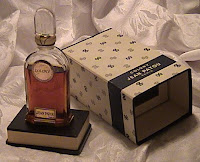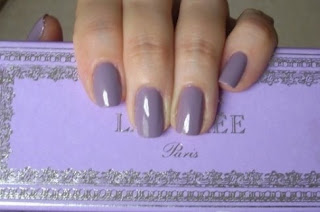 By Donna
By DonnaIn this the final installment of my series on the perfumes of Dawn Spencer Hurwitz, I have saved a special group of fragrances for last. Even among the offerings of a niche perfumer, these are unusual both in concept and execution. They are the scents of
The Perfumed Court series and there is a dual theme – they are both inspired by the royal personalities at the court of Versailles in its glory days and made as closely as possible by natural methods, using materials in existence at the time. DSH created these entirely of natural botanicals except for the animalic notes that are unavailable today, so a few synthetics are used for those. However, the way these smell, you would never know they were anything but all natural. I tried one of them when the samples first arrived, and I knew immediately that they were in a category apart from the others. I waited until I had finished testing the rest of the scents before coming back to these. In fact, except for the first one I tried, I did not look at the notes before trying them; I anted to be challenged and surprised.
One of the simplest in composition is
Eau de Fleurs d’Oranger du Roi (
Orange Blossom Water of the King), inspired by a favorite “signature” scent of Louis XV, made entirely of citrus and a tiny touch of Ambergris – in fact it is 99.99% natural with the exception of the synthetic Ambergris. I really liked this a lot – unlike the Fleurs d’Oranger from the Les Rouges series, it is not warm and honeyed but fresh and soapy, the character of the living flowers bursting forth. The soapy quality is not a favorite for everyone, but I love it, and this would be ideal for summer, as it holds to that clean aroma all day long. It does get a bit sweeter as time passes but the freshness never goes away. Notes are Bitter Orange, Lemon, Italian Neroli, Orange Flower Absolute (France), Orange Flower Water, Ambergris, and Petitgrain. Short, sweet and to the point, it has a charm all its own.
Even more transparent is the herb-infused
Eau de Cologne/Aqua Admirabilis. This 100% botanically sourced scent is a blend of citrus ingredients such as Lemon, Neroli and Petitgrain with the addition of Lavender and Rosemary. The herbal character is evident but never attains dominance over the citrus, even though both of them are certainly powerful enough to do it. The main impression is of delightful lemon and orange notes made even zestier by being perfectly counterbalanced by the herbs. This one is not sweet at all and is very much in the tradition of classic Eaux de Cologne such as 4711 and Guerlain’s
Eau de Cologne Imperiale. (I generally shy away from too much Rosemary in fragrances, since it always makes me think of “non-perfumey” foods such as roasted chicken, but I quite liked it, the herbal dosing is just right and nary an oven-browned fowl is in evidence.) This is one to reach for on those unbearably hot and humid summer days when you can’t stand the idea of anything sweet on your skin.
The famous Madame du Barry, the last official mistress of Louis XV, inspired
Eau de Coquette. When I first put it on it seemed to be a simple bouquet with a sweetly aromatic hay-like herbal quality to it. However, that was deceptive; as time passed, the hay character subsided and was replaced by the spicy warmth of Nutmeg, Centifolia Rose, Orange Flower and a rich, sweet Jasmine. The herbal opening was Angelica, and it was like a little Trojan horse –while I was smelling it and trying to figure out what it was doing, all these lovely floral notes sneaked in. I know some people do not care for Angelica, but in this perfume it does not dominate or give off that odd wetness it can sometimes have. It is beautifully balanced with the florals, and matches especially well with the Orris that chimes in a little later. The overall effect of the florals and the spice was like a subtly sweet carnation to me, the kind of Garden Pink that smells so delicious on a sunny day. An Ambergris base gives it excellent longevity. Eau de Coquette was made using the actual notes of an 18th century perfumer who made a perfume very like this one for Madame du Barry, and my hat is off to Monsieur Jean-Louis Fargeon – he really knew how to make a good perfume. I am delighted that an old formula like this can be brought to life again; if this is any indication of the fragrances common to the 18th century, I say let’s resurrect more of them.
As
Eau de Coquette is intended for evening seduction, so is the other Madame du Barry inspired scent meant for day wear. It is called
Eau de la Favourite and it is definitely of a different style, although it is also based on a formula by the same perfumer as its sister scent. It begins with a delicious burst of orange and lemon flowers, and then quickly becomes a lightly sweet Iris scent with an unusual “carroty” quality, which turned out to be
Daucus accord– also known as “Queen Anne’s Lace” or wild carrot. Some synthetics were used to recreate this unusual note; otherwise this is 96.5% natural botanicals. Orris root imparts a velvety smooth Violet note to the composition. My only quibble with Eau de la Favourite was that opening did not last long enough for me – the fresh orange is truly mouth-watering for about five minutes, then fades as the heart notes start to take over. The complete list of ingredients: Top notes of Esprit de Fleurs de l’Orange, Lemon. Heart notes: Orange Flower Absolute, Orris Concrete, and Orris Root. Base notes: Daucus accord, Eau de vie de Cognac, Mace. The cognac and spice notes are very subtle but they provide an intriguing backdrop to the rest. At first I thought it was not going to last very long, but once the opening florals subsided it became a lovely soft skin scent that really grew on me. I would recommend it for warm weather– it’s a pretty, happy fragrance that feels like a carefree summer day.
I had no idea what to expect from
Cyprian, which is 100% natural and derived from a recipe for a popular wig powder and hair pomade of the era. Come to think of it. I never thought much about what a powdered wig might smell like! If this fragrance is any indication, then the royal Court must have been a pleasantly aromatic place, for this is a truly lovely perfume. It opens with intensely green Bergamot and herbal notes, and soon turns to the softest, most gentle Violet/Iris fragrance I have ever experienced. As subdued as it becomes, it lasts a long time, and it’s a poster child for the term “skin scent.” I am sometimes disappointed with overly powdery Iris perfumes, but this is not really powdery at all, despite its derivation from a hair grooming preparation. It dries down to deep mossiness that I found irresistible. It is definitely a unisex fragrance and seasonless as well, and I would gladly wear it anytime; I have never been quite so charmed by an Iris perfume as I was by this simple little gem. Notes are listed as Bergamot, Clary Sage, Orris Concrete, Orris Root, Violet Leaf Absolute, French Oakmoss and Rosewood (Bois de Rose.)
Eau de Trianon is, of course, a tribute to Marie Antoinette and her country retreat and is based on detailed notes from a perfume created for her by the talented Jean-Louis Fargeon. The Queen commissioned him to create a perfume that would remind her of her beloved gardens. It started out as a soft pastoral floral on me and then took a strange turn into sugared celery territory. The celery aroma, which naturally turned out to be Galbanum, soon subsided into a gently green herbal quality, and the sugar turned into Orange Blossom and Lemon, leaving what I would describe as a misty fragrance with a touch of melancholy, like an early morning walk before the dew evaporates. It contains Rose and Jasmine, but these are not much in evidence to my nose, as they are subordinate to the cooler notes of Jonquil, Orris and Violet Leaf as the scent’s heart notes are revealed. It is a very pretty scent but not as substantial as one would think, considering the base notes of Ambergris, Atlas Cedarwood, Benzoin and Vanilla Absolute. The benzoin I do get, but the wood and vanilla are very faint. I think this one is probably much more true to itself in Parfum strength. The citrus notes were surprisingly persistent to the end.
In contrast to the wistful
Eau de Trianon,
Mille-Fleurs Bouquet goes on rich and heady. Opening with Cassie, Lavender and citrus notes, it bursts with Rose Geranium and profoundly scented Gallica Rose Otto, as well as Jasmine, Orange Flower and Violet. Ambrette Seed, Brazilian Vetiver and Vanilla Absolute make for a lovely drydown and excellent longevity. The rather frilly name notwithstanding, this would be suitable for men and women alike. There is quite a lot of Lavender in this but I did not find it to be at all medicinal or overpowering. It seems to be much more about the flowers than the leaves and thus is not as intrusive or dominant as it can be in some perfumes.
Mille-Fleurs Bouquet was another “sneaker” for me – it seemed conventional enough at first but as it developed I kept finding new and different things to love about it. Despite the high floral count it has a fresh and vivid air, and the generous dose of vetiver ensures that it never gets sweet. It reminds me of the tumbling exuberance of a cottage garden where the herbs and blossoms intertwine and mingle their essences together to create an oasis of olfactory pleasure.

One of the “curses” of having a very sensitive nose is dealing with smells that are not good. I cannot stand the smell of cilantro, also known as coriander. The fresh leaves of this love-it-or-hate-it plant are barely tolerable to me when mixed in with other ingredients and unbearable alone. The origin of this aversion is a bad garden experience I had many years ago - I decided to grow some cilantro in my garden. (At that time, I did not dislike it.) The mistake I made was in smelling the fresh green seeds – far more concentrated in their odor than the leaves, they were so repulsive that they put me off the fresh stuff altogether. But something magical happens when coriander seed is allowed to ripen and then dry completely; they develop a warm and savory taste and aroma that I love. So I was pleasantly surprised to find Coriander seed present in abundance in
Pot-Pourri de Pompadour, a re-creation of a traditional wet potpourri recipe. It is just delectable, a zingy herbal blend that perked up my senses the moment I put it on. It may have been made from a formula for a room fragrance, but my skin loved it. I can’t imagine a better way to wake up on a summer morning than to splash this stuff on. The complete list of notes: Coriander Seed, Crushed Mint, Lavender Flower, Rosemary, Allspice, Egyptian Rose Geranium, Lemon Balm, Marjoram, Palma Rosa, Centifolia Rose Absolute, Jonquil, Orris Root. If only all homes smelled this good.
The perfume I tried first from this group, and then put away until I could focus on them completely, was the gorgeous
Reinette. Similar in its headiness to
Mille-Fleurs Bouquet, it has the added dimension of Hyacinth in its composition, along with Carnation and Tuberose. It is flagrantly romantic yet fresh and lifelike, and again is not overly sweet despite the abundance of florals. (In fact, none of these scents are, which leads me to believe that today’s overly sugared perfumes must have a lot of synthetics in them to create that impression, along with too much cheap vanilla and other things that mask overall poor quality.) It is a tribute to Jeanne Poisson, the Marquise de Pompadour, the most influential mistress of Louis XV and the person most responsible for introducing the art of bathing to the Court, for which we all must be very grateful indeed. Hyacinth was said to be her favorite flower, which seems perfect for a woman who loved cleanliness. Cassie and Rose soften its airy sharpness, but the centerpiece of this “little Queen” of a perfume is the delicious Hyacinth, also a favorite of mine, and wearing it made me feel like a Queen of luxury. Try this one if you want to be noticed.
Le Roi Soleil is of course, named for Louis XIV The Sun King himself, and it’s worth of bearing the name. It is meant to be a masculine scent, and it succeeds admirably in that regard, but I enjoyed wearing it very much and I think anyone else would too. It is the most complex of The Perfumed Court series, as befits a monarch. Opening with the high notes of Bergamot and Lime Peel, it becomes warm and spicy as it develops. Carnation and Clove are much in evidence as well as a very high quality Orange Blossom and the pleasing warmth of Oregano. It is the most sophisticated in composition of this group, with base notes that include two kinds of Oakmoss, Frankincense and Leather. It is possible to glimpse the origin of today’s perfume blends with this kind of scent. Smooth and elegant, it could be presented as a modern introduction by a major house and no one would be the wiser. While it is technically modern, of course, it is made of natural materials with only a trace of animalic synthetics, being 98.9 % naturally sourced. I found the leather and oakmoss drydown to be exceedingly pleasing, and the intertwining of the incense and ambrette seed with these elements made it downright addictive. Its construction is traditional but it has enough of a twist to it to make it very interesting. I would stack Le Roi Soleil up against any prestige men’s fragrance available today. Full list of notes: Bergamot, Lemon, Lime Peel, Rosemary, Rosewood Sweet Orange, Carnation Absolute, Clove Bud, Esprit de Fleurs d’Oranger, Esprit de Lavande, Grandiflorum Jasmine, Origanum, Ambergris, Ambrette Seed, Brown Oakmoss, Castoreum, Frankincense, Green Oakmoss, Infusion of Leather, Sweet Birch. (Did I mention I am a birch lover? And that it pairs superbly with incense?)
* * * ** * * ** * * ** * * ** * * *
This concludes the DSH Perfumes series. It is by no means a complete list of all of the DSH offerings, for there are many more to explore. It is more of an overview of the impressive variety to be found within the line. (I am already starting to miss having a new one to try almost every day.) Please bear in mind that I only sampled the Parfums des Beaux Arts and none of the Essense series of Aromatherapy oils. That is a whole different world, which I hope to explore someday soon. I must say that now that I know how high the quality of the offerings I would not hesitate to order either the oils or perfumes, even untested. Of all the ones I tried only a few did not suit me but their quality was not the issue, rather my own chemistry and/or preferences.
One thing that really emerged as I tested each perfume was how they presented themselves right at the beginning – since they are mostly natural, there is no opening blast of aldehydes or other materials that distract from the perfume’s true character, and they are not overloaded with alcohol either. So many of today’s perfumes are made so that the top notes “sell” the scent and they are laden with top-heavy ingredients so that the perfume may be unrecognizable after thirty minutes on the skin, and then it’s a disappointment, like those buildings on Old West movie sets that are nothing but flat fronts propped up in back. The DSH scents do change with time like any other of course, but there is an immediate accessibility about them – their character is apparent from the beginning and they don’t switch identities once they have captivated the wearer. In this way they are more like classics from an older perfume house, despite their mostly modern feel, than the scents made in today’s laboratories and approved by focus groups.
My other impression is the great diversity within this line. If I count only some of my very favorite ones, I come up with a full spectrum of fragrances for a scent wardrobe. Consider the rich decadence of
Mahjoun, the damp tropical languor of
Padme Lotus, the gauzy delicacy of
Cielle, the delicious contradiction of
Piment et Chocolat, the intriguing masculinity of
Le Roi Soleil and
Jitterbug for Men, the mystery of
Arome d’Egypt or the heartbreaking melancholy of
Memory and Desire No. 1. Hard to believe they are all the products of one perfumer, but the common thread of dedication to natural materials and consistent high quality ties them together.
I would like to offer a sampler of these perfumes, gambler’s choice only, so if you would like to be included, please indicate your interest in the comments section. The winner’s name will be announced the week after this post appears. (Some of them will not be full vials, but there will be enough for one or two wearings in each.)
Image credits: The famous Hall of Mirrors at Versailles from picasweb.google.com; Rococo style portrait of the Marquise de Pompadour by artist François Boucher from myartprints.co.uk. By Donna
By Donna  On the sweeter side, Comptoir Sud Pacifique has Vanille Pineapple, with the fruit accompanied by frangipani, coconut, vanilla, sugar, cinnamon, passion fruit and musk. As with most CSP scents, the top notes fade rather quickly, leaving the vanilla, coconut and sugar to duke it out, and in this case the top note is just pineapple. It’s a fun perfume, make no mistake, but not everyone wants to smell like pineapple upside-down cake all day. (Not that there’s anything wrong with that.)
On the sweeter side, Comptoir Sud Pacifique has Vanille Pineapple, with the fruit accompanied by frangipani, coconut, vanilla, sugar, cinnamon, passion fruit and musk. As with most CSP scents, the top notes fade rather quickly, leaving the vanilla, coconut and sugar to duke it out, and in this case the top note is just pineapple. It’s a fun perfume, make no mistake, but not everyone wants to smell like pineapple upside-down cake all day. (Not that there’s anything wrong with that.)













 China Glaze Agent Lavender is lovely taken on its own merit, but too blue Laduree-box-wise. At times it looks to me light periwinkle more than lavender. It had amazing creamy texture and easy application. This is the kind of polish that appears as though it would apply unevenly and then miraculously spreads on a nail flawlessly all on its own. It is also a perfect match to tanzanites in one of my favorite rings and so it more than earns its place in my collection.
China Glaze Agent Lavender is lovely taken on its own merit, but too blue Laduree-box-wise. At times it looks to me light periwinkle more than lavender. It had amazing creamy texture and easy application. This is the kind of polish that appears as though it would apply unevenly and then miraculously spreads on a nail flawlessly all on its own. It is also a perfect match to tanzanites in one of my favorite rings and so it more than earns its place in my collection.
























